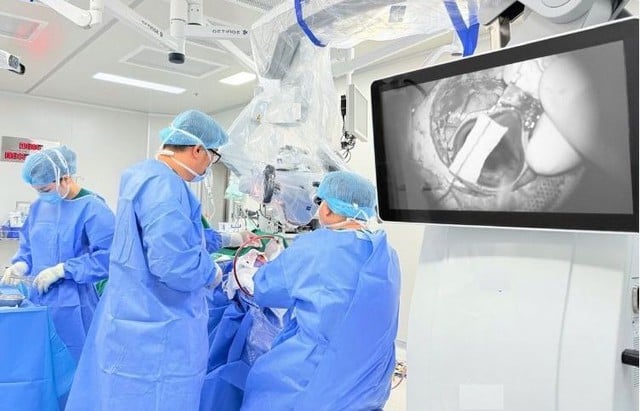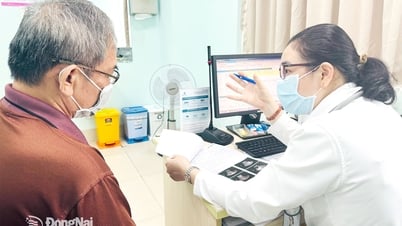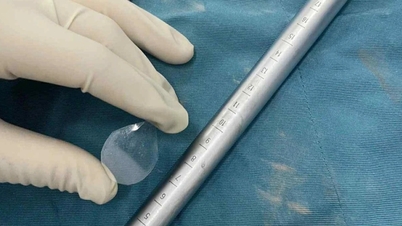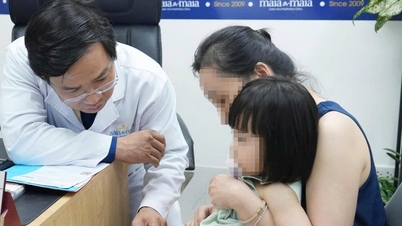CT scan results showed that he had a right hemisphere cerebral hemorrhage and was transferred to Tam Anh General Hospital in Ho Chi Minh City for emergency intervention.
On September 23, Master - Specialist Doctor 2 Mai Hoang Vu (Department of Neurosurgery, Center for Neuroscience , Tam Anh General Hospital, Ho Chi Minh City) said that when admitted to the hospital, the patient had high blood pressure of 153/94 mmHg, left arm strength was only 2/5, left leg strength was 3/5, and consciousness was gradually decreasing. The X-ray image showed a hematoma in the right brain about 6 cm, causing cerebral edema, compressing the right ventricle, pushing the midline to the left 4 mm, very critical.
"Urgent surgery is needed to remove the hematoma, relieve the compression, and end the toxic inflammatory spiral that causes brain edema and expands the damaged area, while preserving as much healthy tissue as possible," said Dr. Vu.
Minimally invasive brain surgery saves hemorrhagic stroke patient
After consultation, the team decided to perform surgery to remove the hematoma for the patient using minimally invasive brain surgery techniques with the support of artificial intelligence (AI) technology. The surgery began with a small incision on the scalp.
A small "keyhole" of about 2 cm in the skull is opened with a high-speed drill, a specialized tube is inserted deep into the brain, selectively following natural grooves, gently separating brain tissue to both sides to create a safe corridor to go deep into the hematoma without damaging healthy tissue. Under the microscope, the team determines the exact location of the hematoma, clearly observes every detail of the small blood vessels, separates and removes the hematoma.

Doctors during surgery on a patient
PHOTO: TA
After surgery, the patient is awake, does not need to stay in the recovery room, the surgical wound is clean and dry.
Three days later, the patient regained consciousness, improved consciousness, and gradually recovered leg movement. CT scan results showed that the hematoma caused by the cerebral hemorrhage had been completely removed, the ventricles were only slightly compressed, and the midline had returned to normal. During the postoperative period, the doctor closely monitored vital signs and prevented the risk of rebleeding. After screening and treatment for underlying diseases and stroke risk factors, the patient was discharged and continued rehabilitation with specially designed exercises.
Dr. Vu recommends that people with underlying medical conditions such as high blood pressure, diabetes, lipid disorders, etc. need to have regular health check-ups, comply with treatment, and maintain a healthy lifestyle. When unusual symptoms such as weakness, difficulty speaking, crooked mouth, severe headache, etc. appear, they need to be taken immediately to a medical facility with stroke emergency expertise for timely intervention.
Source: https://thanhnien.vn/nguoi-dan-ong-bat-ngo-dau-dau-du-doi-nga-quy-do-xuat-huyet-nao-185250923094635958.htm




![[Photo] Hanoi morning of October 1: Prolonged flooding, people wade to work](https://vphoto.vietnam.vn/thumb/1200x675/vietnam/resource/IMAGE/2025/10/1/189be28938e3493fa26b2938efa2059e)
































![[Photo] Panorama of the cable-stayed bridge, the final bottleneck of the Ben Luc-Long Thanh expressway](https://vphoto.vietnam.vn/thumb/1200x675/vietnam/resource/IMAGE/2025/9/30/391fdf21025541d6b2f092e49a17243f)


























































Comment (0)